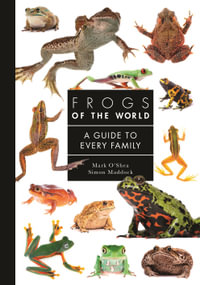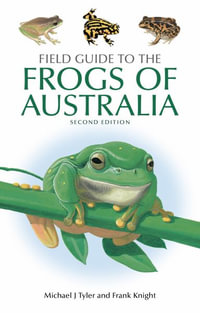
Amphibian Biology, Volume 11, Part 4
Status of Conservation and Decline of Amphibians: Eastern Hemisphere: Southern Europe & Turkey
By: Harold Heatwole (Editor), John W. Wilkinson (Editor)
Paperback | 15 December 2014
At a Glance
172 Pages
24.4 x 17.0 x 0.94
Paperback
$150.42
or 4 interest-free payments of $37.60 with
orAims to ship in 7 to 10 business days
Amphibian species around the world are unusually vulnerable to a variety of threats, by no means all of which are properly understood. Volume 11 in this major series is published in parts devoted to the causes of amphibian decline and to conservation measures in regions of the world. This volume, Part 4 in the series, is concerned with Southern Europe (Italy, Malta, Croatia, Slovenia, Serbia, Montenegro, Bosnia and Herzegovina, Macedonia, Albania, Greece, Romania, Hungary, Bulgaria, Turkey, and Cyprus).
Each chapter has been written by experts from each country, describing the ecological background and the conservation status of affected species, with an emphasis on native species. As well as infectious diseases and parasites, threats take the form of introduced and invasive species, pollution, destruction and alteration of habitat, and climatic change. These are discussed as they affect each species. All these countries have monitoring schemes and conservation programs, whose origins and activities are described. Recommendations for action are also made.
Edited by leading scholars in the field, Volume 11, when complete, will provide a definitive survey of the amphibian predicament and a stimulus to further research with the objective of arresting the global decline of an entire class of animal.
Industry Reviews
Studies of population declines have increasingly dominated global research effort on amphibians since the first World Congress on Herpetology in 1989. As has been often pointed out, this now legendary meeting bought together specialists from many countries and when they compared their individual observations, they realized that amphibian declines were widespread in occurrence around the world. A search for a common cause examined many possibilities, among them the accelerating habitat alteration by ever-increasing human populations, increased human harvesting for food and the pet trade, effects of introduced species, pollution, parasites, the spread of the chytrid fungus, and the effects of ultraviolet light and global warming.
Volume 11 tackles aspects of regional declines as the latest in a wide-ranging comprehensive series of volumes on amphibian biology. Each of the volume's 4 parts, issued separately, is devoted to regional causes of amphibian declines and the conservation measures attempted. Part 4 contains chapters 39 to 53 authored by one to three of the 25 regional researchers concerned with Southern Europe and Turkey, who contributed to chapters on Italy, Malta, Croatia, Slovenia, Serbia, Montenegro, Bosnia, Herzegovina, Macedonia, Albania, Greece, Romania, Hungary, Bulgaria, Turkey, and Cyprus. The cover features a male Bombina floating on the surface of a breeding site in Hungary. Each chapter summarizes, for the included country, amphibian habitat, species present, their population status, and the extent of studies to date. Many have useful tables and graphs. Also included are the existing protection, major threats, monitoring schemes and conservation programmes and action recommendations. Each country account has its own references section, the majority of included titles are in English but contributions in several other languages add to their comprehensiveness. Virtually all references were published in the 1990s and 2000s. An index to species in all accounts concludes the book.
The editors have solid credentials for assembling the many contributions. Their wide contacts are reflected by their positions and experience. Harold Heatwole is an ecologist and herpetologist currently Professor of Biology at North Carolina State University and Adjunct Professor of Zoology at the University of New England. He is Editor-in-Chief of the journal Integrative and Comparative Biology and a Fellow of the Explorers Club. John W. Wilkinson is a conservation biologist specializing in monitoring amphibians and reptiles. For eight years he was International Coordinator of the Declining Amphibian Populations Task Force and is currently Science Program Manager for the charity Amphibian and Reptile Conservation.
This collection is a welcome contribution to help balance the dominance of current northern research output from North America. They provide additional and broader context to the perspective of the problem and comparison of the study approaches underway in a different continent. Although the western and eastern northern continents have no amphibian species in common, they share many similar genera and habitats available to them. Not surprisingly the most dominant threats to amphibians are common to both: habitat loss due to human activities, over harvest, and introduced species. Increasingly, the chytrid fungus is being detected, likely spread by human introductions from contaminated areas. Even in relatively lesser developed countries, highway mortality and poaching are also concerns. Present ongoing studies will at least provide a baseline for future measurement of the success, or lack of it, of current conservation measures that are being attempted to assure a sample of the biodiversity of their region survives.
-- Francis R. Cook * The Canadian Field Naturalist *More than 20 years ago, Harold Heatwole and collaborators started publishing a series of volumes aiming at cover all the aspects of amphibian biology, from morphology to conservation. So far, ten volumes have been completed (see Brattstrom 2013 for a more complete review or previous volumes): 1: Integument (1994). 2: Social behaviour (1995). 3: Sensory perception (1998). 4: Paleontology (2000). 5: Osteology (2003). 6: Endocrinology (2005). 7: Systematics (2007). 8: Amphibian decline: diseases, parasites, maladies and pesticides (2009). 9: Status and decline of amphibians in the Western Hemisphere. For the Western Hemisphere, to date, three separate parts have been published, covering: Paraguay, Chile and Argentina (2010); Uruguay, Brazil, Colombia, and Ecuador (2011); Venezuela, Guyana, Suriname, and French Guiana (2013). 10: Conservation and decline of amphibians: ecological aspects, effect of humans and management (2012).
Given the broadening interest toward amphibian conservation, many amphibian biologists were waiting for more volumes, increasing the global coverage of volumes on amphibian conservation. In 2013, a new volume, on the status of conservation of decline of amphibians in the Eastern Hemisphere (volume 11) has started the publication, with three parts published from 2013 to 2014: Asia (2014), North Africa (2014), Western Europe (2013).
The most recent volume of the series (Volume 11, Part 4) is the "Status of Conservation and Decline of Amphibians: Eastern Hemisphere: Southern Europe and Turkey", which covers amphibian conservation across 15 countries in the Southeastern side of the Mediterranean Basin. Within the Western Palearctic, this is among the areas with the highest richness and endemism of amphibians. This region suffers a high human impact since many centuries, making detailed information on amphibian conservation essential. In the last decades, a growing number of amphibian specialists are working on amphibian conservation in this areas, boosting our knowledge on how amphibians react to threats, and on which strategies may improve their status. For these reasons, a volume summarizing the knowledge in the areas is really welcomed, as the information is currently jeopardized over hundreds of papers in multiple journals, and in many volumes published by the very active regional herpetological associations.
The volume is organized in 15 chapters, each covering one country / region: the Italian region, Malta, Croatia, Slovenia, Serbia, Montenegro, Bosnia and Herzegovina, Macedonia, Albania, Greece, Romania, Hungary, Bulgaria, Turkey and Cyprus. Each chapter has been written by local experts, and this allows readers to have easy access to local information, that may be of very difficult access given the fragmentation of herpetological literature. Each chapter is subdivided in multiple parts, and generally i) introduces the ecological and biogeographical background of the region; ii) summarizes the species present in the country, evaluates their status and identifies the most threatened species at the national scale; iii) identifies the main pressures threatening amphibian species; and iv) describes the main conservation measures ongoing or necessary in the country.
Each chapter is a summary of the information in one country, based on literature reviews for countries where more studies have been performed, but also on the long experience of the authors for countries where less published studies are available. Chapters are highly heterogeneous among them. For instance, the chapter on Italy by Franco Andreone offers a very wide and in-depth analysis of the threats acting in this country, while other chapters remain vaguer, and only present general information on amphibian threats and conservation actions. Only a few chapters also explicitly analyze original data. The chapter on Hungary by Judity Voros et al. is striking as, for each species, it reports a great amount of new data on distribution and population trends, thus making this chapter a unique resource for amphibian conservation in the country.
Overall, this last volume offers a unique collection of information, and can be an important source of data for all people interested to amphibian biology, but also for management agencies. In my view, the high heterogeneity among chapters is both the strength and a limitation of a volume integrating the work of many authors over multiple countries. A reader may prefer a more homogeneous book structure, with a similar amount and typology of information for all the countries, and with more data for the less studied areas. However, such heterogeneity is probably natural in a volume covering a range of territories in which the tradition and intensity of herpetological studies is so variable.
A final comment on the overall structure of volume 11, which, as I have said before, is being published in multiple parts. Gathering experts from many countries together is a major challenge, and therefore it is not surprising that the parts on different regions are published separately. On the other hand, each part does not have huge size-for instance, this last part on Southern Europe is 158 pages. In my view, keeping volume 11 divided in so many small parts, published in different years and by different publishers, reduces the overall accessibility of the book. Personally, I would have preferred less parts, with broader scope. For instance, the two parts on Europe plus the one on Northern Africa altogether just have 400 pages. Perhaps one single book, putting together all the information on this biogeographically coherent region, would have helped to limit the jeopardization of information and increased the interest for readers. In any case, amphibian biologists are still waiting for more volumes, and we all hope volumes covering the whole globe will be published soon.
Reference
Brattstrom, B. H. 2013. Book reviews. Amphibian Biology, Volume 10. Integrative and Comparative Biology 53: 535-537.
-- Gentile Francesco Ficetola * Phyllomedusa *
This book very usefully compiles under a single cover a large body of information that would otherwise be widely dispersed between specialist journals and regional literature.
-- Richard A. Griffiths * Herpetological Bulletin *ISBN: 9781907807534
ISBN-10: 1907807535
Series: Amphibian Biology
Published: 15th December 2014
Format: Paperback
Language: English
Number of Pages: 172
Audience: Professional and Scholarly
Publisher: Pelagic Publishing
Country of Publication: GB
Dimensions (cm): 24.4 x 17.0 x 0.94
Weight (kg): 0.28
Shipping
| Standard Shipping | Express Shipping | |
|---|---|---|
| Metro postcodes: | $9.99 | $14.95 |
| Regional postcodes: | $9.99 | $14.95 |
| Rural postcodes: | $9.99 | $14.95 |
How to return your order
At Booktopia, we offer hassle-free returns in accordance with our returns policy. If you wish to return an item, please get in touch with Booktopia Customer Care.
Additional postage charges may be applicable.
Defective items
If there is a problem with any of the items received for your order then the Booktopia Customer Care team is ready to assist you.
For more info please visit our Help Centre.
You Can Find This Book In

BLACK FRIDAY
RRP $49.99
$24.95
OFF
This product is categorised by
- Non-FictionScienceBiology, Life SciencesZoology & Animal SciencesZoology & VertebratesAmphibians
- Non-FictionEarth Sciences, Geography, Environment, PlanningThe EnvironmentConservation of The EnvironmentConservation of Wildlife & Habitats
- Non-FictionNature & The Natural WorldWildlife in GeneralWildlife & Reptiles & Amphibians
- Non-FictionScienceBiology, Life SciencesZoology & Animal SciencesAnimal Ecology
- Non-FictionScienceBiology, Life SciencesZoology & Animal SciencesZoology & VertebratesFishes & Ichthyology
- Non-FictionEarth Sciences, Geography, Environment, PlanningThe EnvironmentApplied Ecology
- Non-FictionScienceBiology, Life SciencesLife Sciences in GeneralEcological Science






















